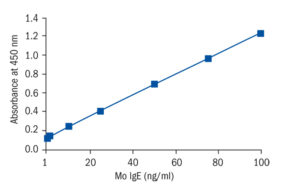Immunoglobulin E Mouse ELISA
IgE (Immunoglobulin E) is a glycoprotein with a molecular size of 190 kDa composed of 2 light chains and 2 heave chains (H ). In electrophoresis, it moves to γ1 region. Its biological half life is about 3 days, and its blood level in normal human subject is very low, about 300 ng/ml. The blood level of IgE increases markedly in parasite infection and in hay fever. IgE that is responsible for allergy has been called “reagin”. Sensitization by an allergen increases reagin IgE which binds to FcεR1 receptor in basophilic leucocytes and mast cells at Fc region and sensitizes those cells. If the allergen binds the sensitized cells, those cells will be degranulated and release histamin, serotonin, protease, heparin, chemotactic factor, prostaglandins, leucotriens, and so on, causing bronchoconstriction, mucous edema, and hypersecretion, and leads to type I allergic reactions like bronchial asthma, hives, allergic rhinitis, anaphylaxis, and so on. This is the assay kit for total mouse IgE. Shibayagi is also providing assay kits for allergen(OVA)-specific mouse IgE.
Type
Sandwich ELISA, Biotin-labelled antibody
Applications
Serum, Plasma
Sample Requirements
5 µl/well
Storage/Expiration
Store the complete kit at 2–8°C. Under these conditions, the kit is stable until the expiration date (see label on the box).
Calibration Curve

Calibration Range
1–100 ng/ml
Limit of Detection
50 pg/ml
– Fujimoto M, Tsutsui H, Xinshou O, Tokumoto M, Watanabe D, Shima Y, Yoshimoto T, Hirakata H, Kawase I, Nakanishi K, Kishimoto T, Naka T. Inadequate induction of suppressor of cytokine signaling-1 causes systemic autoimmune diseases. Int Immunol. 2004 Feb;16 (2):303-14
– Horiuchi M, Seyama Y. mprovement of the Antiinflammatory and Antiallergic Activity of Bidens pilosa L. var. radiate SCHERFF Treated with Enzyme (Cellulosine). Journal of Health Science. 2008;54 (3):294-301
– Lee SH, Sohn YS, Kang KK, Kwon JW, Yoo M. Inhibitory effect of DA-9201, an extract of Oryza sativa L., on airway inflammation and bronchial hyperresponsiveness in mouse asthma model. Biol Pharm Bull. 2006 Jun;29 (6):1148-53
– Matsumoto J, Matsuda H. Mast-cell-dependent histamine release after praziquantel treatment of Schistosoma japonicum infection: implications for chemotherapy-related adverse effects. Parasitol Res. 2002 Oct;88 (10):888-93
– Ogawa T, Hashikawa S, Asai Y, Sakamoto H, Yasuda K, Makimura Y. A new synbiotic, Lactobacillus casei subsp. casei together with dextran, reduces murine and human allergic reaction. FEMS Immunol Med Microbiol. 2006 Apr;46 (3):400-9
– Okamoto N, Murata T, Tamai H, Tanaka H, Nagai H. Effects of alpha tocopherol and probucol supplements on allergen-induced airway inflammation and hyperresponsiveness in a mouse model of allergic asthma. Int Arch Allergy Immunol. 2006;141 (2):172-80
– Park EJ, Kim B, Eo H, Park K, Kim Y, Lee HJ, Son M, Chang YS, Cho SH, Kim S, Jin M. Control of IgE and selective T(H)1 and T(H)2 cytokines by PG102 isolated from Actinidia arguta. J Allergy Clin Immunol. 2005 Nov;116 (5):1151-7
– Park EJ, Park KC, Eo H, Seo J, Son M, Kim KH, Chang YS, Cho SH, Min KU, Jin M, Kim S. Suppression of spontaneous dermatitis in NC/Nga murine model by PG102 isolated from Actinidia arguta. J Invest Dermatol. 2007 May;127 (5):1154-60
– Pokharel YR, Lim SC, Kim SC, Heo TH, Choi HK, Kang KW. Sopungyangjae-Tang Inhibits Development of Dermatitis in Nc/Nga Mice. Evid Based Complement Alternat. 2008 Jun;5 (2):173-180
– Takagi H, Saito S, Yang L, Nagasaka S, Nishizawa N, Takaiwa F. Oral immunotherapy against a pollen allergy using a seed-based peptide vaccine. Plant Biotechnol J. 2005 Sep;3 (5):521-33
– Tsukuba T, Okamoto K, Okamoto Y, Yanagawa M, Kohmura K, Yasuda Y, Uchi H, Nakahara T, Furue M, Nakayama K, Kadowaki T, Yamamoto K, Nakayama KI. Association of cathepsin E deficiency with development of atopic dermatitis. J Biochem. 2003 Dec;134 (6):893-902
– Yuda H, Adachi Y, Taguchi O, Gabazza EC, Hataji O, Fujimoto H, Tamaki S, Nishikubo K, Fukudome K, D’Alessandro-Gabazza CN, Maruyama J, Izumizaki M, Iwase M, Homma I, Inoue R, Kamada H, Hayashi T, Kasper M, Lambrecht BN, Barnes PJ, Suzuki K. Activated protein C inhibits bronchial hyperresponsiveness and Th2 cytokine expression in mice. Blood. 2004 Mar 15;103 (6):2196-204

